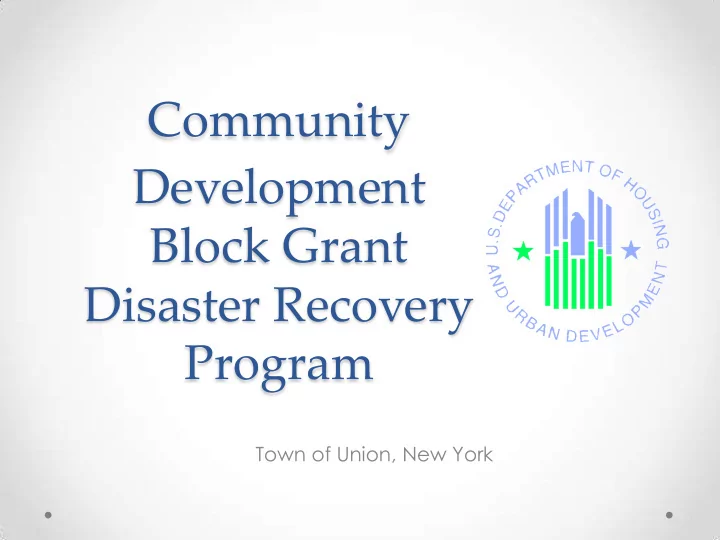

Community Development Block Grant Disaster Recovery Program Town of Union, New York
How HUD Determines Allocations Over the past decade, • HUD has developed an allocation process which focuses on unmet recovery needs. HUD receives data from FEMA and the SBA identifying damage estimates in major disaster areas. HUD considers the • contribution of insurance, FEMA grants, and SBA loans in estimating the severe unmet needs not already addressed by these sources.
In the immediate aftermath of the September 2011 flood event, a number of federal agencies, including FEMA and the Small Business Administration (SBA), began preparing Preliminary Damage Estimates (PDAs) in order to determine whether the severity and magnitude of the event was such that response efforts would be beyond the capabilities of the state and local governments and whether federal assistance would be required. This analysis forms the basis for the Governor’s request for a major disaster or emergency declaration.
On September 13, 2011, the president declared that a major disaster existed in New York State (FEMA-4031-DR), thereby making Individual Assistance available to affected individuals and households in five counties, including Broome County. The declaration also made Hazard Mitigation Grant Program assistance available for hazard mitigation measures statewide. Based upon this review of conditions on the ground, it became clear that Broome County suffered the most severe damage, accounting for 36% of the statewide severely damaged homes and 30% of severely damaged businesses. Within the county, the Town of Union suffered the worst damage, resulting in unmet needs sufficient enough to warrant the Town of Union receiving a direct grant award from HUD.
Getting Started Representatives from the Town and Villages of Endicott • and Johnson City were asked to submit an inventory of flood related projects that they would like to have considered for funding from the CDBG-DR grant. The projects were reviewed for eligibility and prioritized by need. Department heads prepared a summary of unmet flood • related needs for their respective areas of operation. For Public Works, this included a brief narrative for reconstruction projects detailing how the project was tied to the flood and highlighted projected project costs and estimated how much of the project cost was likely to be reimbursable from other sources such as FEMA .
Documenting A Tie To The Disaster The Town documented how each activity addressed a disaster- related impact and how it served to restore housing, infrastructure, or the economy. Examples of documentation included: Damage or building estimates for physical losses; • Post-disaster analyses or assessments for economic or non- • physical losses.
The Town of Union Planning Department mailed out nearly 2,000 surveys to both residential and non-residential property owners in areas that may have experienced flooding based upon inundation maps that were prepared after the flood. The survey was designed to provide information that would allow the Town to better understand what unmet needs may remain in the community.
340 property owners returned surveys to the Planning Department. While this figure represents a return rate of about 17%, which is generally considered to be a significant response for a survey, the Town expected a higher rate of return based upon the severity of the flooding and the funds at hand to address needs. The low response rate could mean that some properties that were in areas that appeared to be flooded may have been spared and the owners did not complete the survey. It could also be indicative of the fact that many owners have applied for a FEMA sponsored buyout and therefore did not feel a need to complete the survey or others who may have simply walked away from the properties and do not intend to return.
Based upon the surveys, it appeared that there were still substantial unmet needs in the community. Homeowners estimated unmet needs at approximately $4.5 million (an average of $37,488 per unit) while business and non-profits estimated remaining unmet needs at just over $3 million (an average of $100,043). In determining how funding would be allocated between various activities, the primary focus of the Town was to repair and improve vital infrastructure that serve and protect the more than 56,000 residents of the Town.
In addition to the unmet housing and business needs previously identified, floodwaters took a significant toll on the basic infrastructure throughout the Town. Roads, storm water facilities, sanitary sewer plants, and water treatment plants also suffered significant damage and substantially complicated the Town’s emergency response efforts. Many of these facilities were built decades ago and were not designed to handle subsequent population growth and resulting development. These facilities were overwhelmed by the ever increasing intensity of storm events and can’t be maintained into the future without significant repairs and flood mitigation measures. Private utilities also experienced significant flood related damage to service delivery components.
Recommend
More recommend